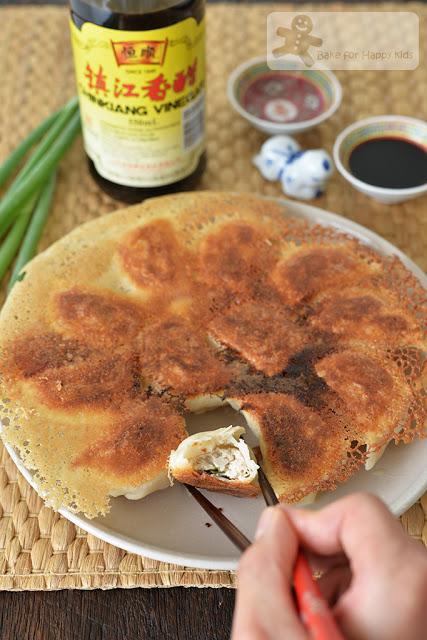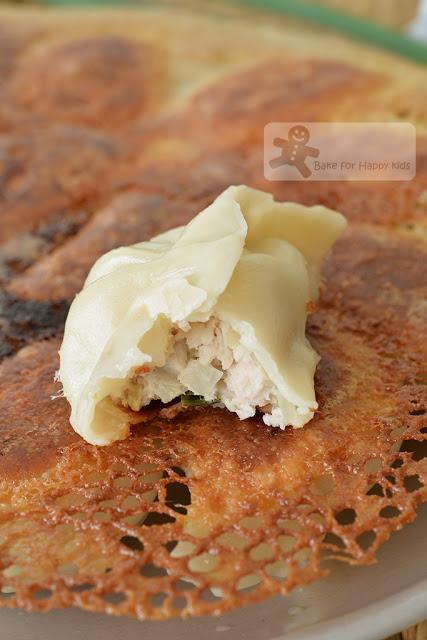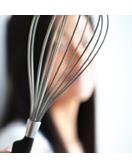... especially when those that are cooked with crispy lattice base. YUMMY!!!
Then, the non-Japanese half-Shangdong me wonder ...
Is there any difference between the Japanese gyoza / 餃子 and Chinese potstickers 锅贴?
According to a thorough explanation at here, the answer is YES!
Or perceptually NO! LOL!
The word 餃子 is known as Jiaozi in Mandarin and Gyoza or ぎょうざ in Japanese and the cooking of Jiaozi first started in Northern China including Shangdong where wheat is their staple crop.
The Chinese version of Jiaozi are dumplings that are made with mince meat and/or vegetable filling wrapped into a thinly rolled wheat flour dough and the dumplings can be either boiled, steamed, pan-fried or even deep fried.
The pan-fried version of Jiaozi is commonly known as potstickers or Guotie in Mandarin because Guo means wok and tie means stick. Why Guotie? This is because potstickers are typically cooked by a fry-steam-fry method. To do so, the base of the dumplings are first fried with a moderate amount of oil. Then, water is added into the pan and covered to steam and cook the dumpling filling. To finish, the cover of the pan is removed so that the water are fully vaporised and the base of the dumplings are fried again until crisp.
How about Gyoza?
The Japanese learned this culinary idea from the Chinese during World War II when they were in Manchuria. After WWII, the Japanese returned home and recreated Gyoza which is Japanese pronunciation of jiaozi.
Does this means that both Japanese gyoza and Chinese potstickers are the same? Based on history, YES but technically, NO!!!
If you observe both gyoza and potstickers very closely, you will see that Japanese gyoza are typically smaller for being one or two bite-sized. And they are usually made from very thin delicate pre-fabricated wrappers with fillings that are more finely chopped and textured.
Whether gyoza or jiaozi or guotie, I must say that I have learned well enough to cook good delicious dumplings these days. Ahem... So good that I have even mastered the art of cooking either gyoza or potstickers with a perfect crispy base.
So good that even my fussy husband said "Wow! Your crispy dumplings really got standard!" and my gyoza-loving mini-food-critic son said "Mum, your crispy dumplings are the BEST!!!"
That's because they didn't know something! The trick to create this crispy base is to add some wheat flour into the water that steam the dumplings! That's all! Now that you know... so please don't tell them. Let them keep saying that I'm best! LOL!

Gyoza 餃子 / Potstickers 锅贴 with Crispy Lattice Base
Want to know how I cooked my gyoza with such yummy crispy base? Here's a video showing how I cooked my dumplings.
Thanks Bensound for the music in my video.
Instead of making my gyoza wrappers from scratch, I'm using the ready made ones that can be bough from any Asian grocery shops.
If you die die must make your own gyoza wrappers, you can try this recipe at here from Just One Cookbook which is the same as Chinese potstickers (guotie) 锅贴 wrappers but you will have to roll the wrappers a little thinner if you are making Japanese gyoza or thicker if you are making Chinese potstickers.
TIPS: To make a good gyoza / potsticker wrappers, you must 1) use boiled water to make your dough but not required or optional if you are making jiaozi wrapper. 2) use top flour or Italian OO pasta flour that is finely milled and has adequate gluten content (about 10-11% protein, not too much or less) 3) knead the dough until it is very smooth 4) always keep the dough moist with wet tea towel and 5) allow the dough to rest and relax enough after kneading.
How do I know these gyoza / potsticker wrappers making tips? Coming from a semi-Shangdong family, we used to cook jiaozi at home very often. And it was my dad's Shangdong originated family that taught my mother how to make authentic jiaozi. Since then, we including everyone of us even when we were little kids made and ate thousands and thousands of jiaozi and guotie during every Chinese New Year.
Why do we eat so many jiaozi and guotie during Chinese New Year? According to my dad's Shangdong family, the boat-shaped jiaozi and guotie symbolise yuan bao (silver and golden ingots) and we were told that making and eating many jiaozi and guotie will make us very very very prosperous!!! So there we go... we really made and ate thousands and thousands of jiaozi and guotie every Chinese New Year!!! LOL! Although our jiaozi are not professionally made with odd shapes and sizes, I must say that those jiaozi making days were really very cozy and memorable.
These days with a really small family of three, I don't make jiaozi from scratch anymore which is actually quite sad. Although the ready-made wrappers are not as tasty as the ones that are made from scratch, they are very convenient to use and good enough to make good dumplings for just the three of us.

Can't talk... Must enjoy these crispy dumplings NOW!!!

Simple and delicious cabbage lean chicken filling wrapped in thin tender wheat dough wrapper
EXTRA YUMMY ... with very very very crispy base.
What should I say?
oishii or 好吃? LOL!
Like this recipe and want more? To get the latest updates, you can follow me at either my Facebook at here or here or my Instagram @zoebakeforhappykids
As this will be my last blog before the arrival of Earth Dog Year and I would like wish everyone...
Gong Xi Fa Cai!
Happy. Healthy. Eat lots of gyoza or potstickers and be prosperous!!!Here's the recipe.
To make 40 to 45 dumplings with healthy lean chicken or pork filling:
1/2 cup finely chopped cabbage
1/2 tsp salt
500g lean chicken or pork mince*
1-2 spring onions, use the green parts only, finely sliced
1 tsp finely grated ginger
1/4 tsp sesame oil
salt and pepper, to season
40-45 gyoza wrappers**
* The cabbage and spring onion will make this lean chicken or pork filling juicy and tender enough to enjoy but if you prefer your dumplings to be ultimately juicy, you should use chicken or pork mince with more fat.
**I used the ready made ones that can be bough from any Asian grocery shops. If you die die must make your own gyoza wrappers, please read my above gyoza making tips (before this recipe).
Combine cabbage with 1/2 tsp salt in a bowl and and leave it to "sweat" for about 10 mins. Use paper towels to blot any excess liquid. - It's important to do this step so that the filling is less wet to make the base crisper!
Combine chicken or pork mince, cabbage, spring onions, ginger and sesame oil in a large mixing bowl. Season with salt and pepper and mix until combined.
To wrap the dumplings:
Place a wrapper on one hand. Place a teaspoonful of filling in the center of the wrapper. Dip one finger from the other hand in a bowl of water and use the wet finger to draw a circle around the wrapper.
Fold wrapper in half. Make about 6 pleats on the half side that is facing you while sealing each pleat with the other half of the wrapper that is facing the other side.
There are 3 different ways that you can fold the pleats:
One is start folding the first pleat in the middle of the dumpling, then folding 2 pleats from the first pleat to right and 3 pleats from the middle to left.
Two is start folding the first pleat at the right end of the dumpling, then folding the remaining 5 pleats from right to left.
Three is start folding the first pleat at the left end of the dumpling, then folding the remaining 5 pleats from left to right.
To cook 12 dumplings with one crispy base:
1 tbsp all purpose / plain flour***
1 cup (250ml) water
2-3 tbsp neutral tasting vegetable oil
12 uncooked gyoza or dumplings
*** I noticed that some people uses corn flour / starch, potato flour / starch, rice flour or even tapioca flour to cook their crispy base but I reckon that all purpose / plain flour works the best for me!!!
Combine flour and water to form a cloudy solution. Set aside.
Heat oil in a medium non stick frying pan with medium high heat. And it is IMPORTANT to add adequate oil or your base won't be crispy!!!
Reduce heat to medium low. Place gyoza into frying pan by arranging them in a circular manner. Cook the dumplings for 2 mins or until the base is light golden.
Stir and pour the cloudy flour solution from the center of the frying pan and let the solution spread out from the center. Cover the frying pan with a tight fitting lid and cook with low heat for about 10 mins or the gyoza filling is completely cooked.Note: If you don't have a frying pan with tight fitting lid, you can also cook the gyoza with a semi-tight fitting lid for about 10 mins and it's ok that 80% of the liquid will vaporised at this stage. Although the use of semi-tight fitting lid is quicker to cook the gyoza, their skins won't be as moist as the ones that cooked with the tight-fitting lid. My frying pan lid is the interchangeable type that can either be tight-fitting or semi-tight fitting. I didn't have to rush for time when I cook this batch of gyoza and so I chose the tight-fitting lid option.
Remove lid and continue to cook until until the liquid has completely vaporised and bubbled off and the base is golden brown and crispy.
Serve with black vinegar with ginger strips or any of your favorite dipping sauces.
Happy CookingPlease support me and like me at Facebook...

